|
SPECsip
Resources
|
SPEC SIP Design Document
Revision Date: September 6th, 2007
1
Overview of SPEC SIP
SPECSIP2008 is a software benchmark product developed by the Standard
Performance Evaluation Corporation (SPEC), a non-profit group of computer
vendors, system integrators, universities, research organizations, publishers,
and consultants. It is designed to evaluate a system's ability to act
as a SIP server supporting a particular SIP application. For SPEC SIP
2008, the application modeled is a VoIP deployment for an enterprise,
telco, or service provider, where the SIP server performs proxying and
registration.
This document overviews the design of SPEC SIP 2008, including design
principles, included and excluded goals, the structure and components
of the benchmark, the chosen workload, and reasons behind various choices.
Separate documents will discuss specifics of how to build and run the
benchmark. Multiple documents exist to describe different aspects of
the benchmark. These include:
- The design document (this document): The overall architecture of
the benchmark.
- Design FAQ: Frequently asked questions about the design of the benchmark,
in Q&A form, not explicitly addressed by the design document.
- Run and reporting rules: How to (and how not to) run the benchmark;
appropriate and inappropriate optimizations; standards compliance,
hardware & software availability.
- User Guide: How to install, configure, and run the benchmark; how
to submit results to SPEC.
- General FAQ: Frequently asked questions about the benchmark; What
is SPECSIP, how can I use it, limitations, software reqs, hardware
reqs, what do I do if I have problems.
- Support FAQ - Frequently asked questions about running the benchmark;
typical problems and solutions encountered.
The remainder of this document discusses the design of the SPEC SIP benchmark.
We assume the reader is aware of core SIP terminology provided by IETF's
RFC 3261, available at http://www.ietf.org/rfc/rfc3261.txt.
In addition, the reader should be aware of Malas' "SIP End-to-End Performance
Metrics" draft, currently available at http://www.ietf.org/internet-drafts/draft-ietf-pmol-sip-perf-metrics-00.txt.
1.1
Design Principles
The main principle behind the design of the SPEC SIP 2008 benchmark is
to emulate SIP user behavior in a realistic manner. Users are the main
focus of how SIP traffic is generated. This means defining a set of assumptions
for how users behave, applying these assumptions through the use of profiles,
and implementing the benchmark to reproduce and emulate these profiles.
These assumptions are made more explicit in the next section.
1.2
Requirements and Goals
The primary requirement and goal for SPEC SIP is to evaluate SIP server
systems as a comparative benchmark in order to aid customers. The main
features are:
- The SUT is the SIP server software and underlying hardware.
- Core SIP operations are exercised (e.g., packet parsing, user lookup,
message routing, stateful proxying, registration).
- Generated traffic is based on best available estimates of user behavior.
- Configurations match requirements of SIP application providers (e.g.,
to require authentication).
- Logging for accounting and management purposes is required.
- The standards defined by core IETF SIP RFCs (e.g., RFC 3261) are
obeyed.
- Assumptions are made explicit so as to allow modifying the benchmark
for custom client engagements (but not for publishing numbers)
The last feature illustrates a secondary additional goal, which is to
aid in capacity planning and provisioning of systems. SPEC SIP explicitly
defines a standard workload, which consists of standard SIP scenarios
(what SIP call flows happen) and the frequency with which they happen
(the traffic profile). Different environments (e.g., ISP, Telco, University,
Enterprise) clearly have different behaviors and different frequencies
of events. SPEC SIP is designed to be configurable so as to allow easy
modification of the benchmark for use in customer engagements so that
the traffic profile and resulting generated workload can be adapted to
more closely match a particular customer's environment. Towards this
end, we make traffic profile variables explicit to allow customization.
However, for publishing numbers with SPEC, the standard SPEC SIP benchmark
with the standard traffic profile must be used.
1.3 Excluded
Goals
Due to time, complexity, and implementation issues, the SPEC SIP benchmark
is necessarily limited. Goals that are excluded in this release of the
benchmark include:
- Completeness: Any benchmark does not capture a complete application,
of course. Instead, it is meant to capture the common-case operations
that occur in practice and that provide a significant impact on overall
performance. SPEC SIP cannot exercise all possible code paths and
is not a substitute for unit or system testing of SIP software.
- Other SIP applications: SPEC SIP 2008 focuses on Voice proxying
and registration and. It does not evaluate instant messaging or presence,
which are planned for future releases of the benchmark.
- Network effects: network characteristics such as packet loss, jitter,
and delay can have substantial impacts on performance. However, network
effects are outside the scope of this benchmark, which is intended
to stress the server software and hardware in relative isolation.
It is expected that organizations running the benchmark will do so
in a high-bandwidth, local-area network environment where the effects
of network characteristics are minimized.
Assumptions are listed in detail in Section 2.5.
2 Component
Outlines
The SPEC SIP 2008 Benchmark consists of several logical components that
make up the benchmark. This section provides a high-level view of the
architecture for how these components fit together and interact with
each other.
2.1
Logical Architecture
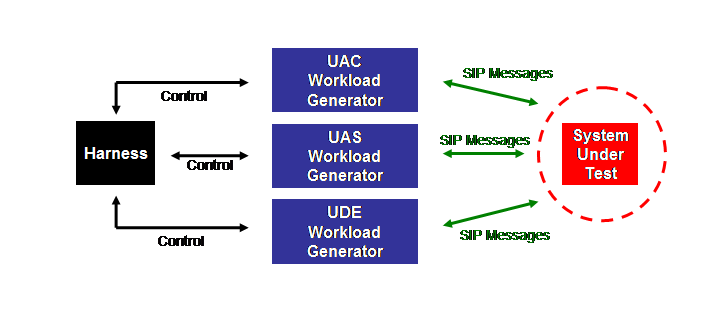
The above Figure shows the logical architecture for how the components
of the benchmark system fit together. The benchmark system simulates
a group of SIP end point users who perform SIP operations through the
System Under Test (SUT).
2.2
SUT (SIP Server for an Application)
The System Under Test (SUT) is the combination of hardware and software
that provides the SIP application (in this case, VoIP) that the benchmark
stresses. The SUT is not part of the SPEC benchmark suite, but is provided
by hardware and/or software vendors wishing to publish SIP performance
numbers. The SUT performs both SIP stateful proxying that forwards SIP
requests and responses between users and registration that records user
location provided by users via the REGISTER request. The SUT receives,
processes and responds to SIP messages from the client SIP load drivers
(UAC, UAS, and UDE, described below). In addition, it logs SIP transaction
information to disk for accounting purposes. The SUT exposes a single
IP address as the interface for communication. More extensive details
about the SUT (namely, requirements) are given in Section 5.1.
2.3
Clients (Workload Generators/Consumers)
Clients emulate the users sending and receiving SIP traffic. Per the SIP
RFC notion of making client-side versus server-side behavior explicit
and distinct, a user is represented by three SIP components, each of
which both sends and receives SIP packets depending on its role.
- The User-Agent Client (UAC), which initiates calls and represents
the client or calling side of a SIP transaction;
- The User-Agent Server (UAS), which receives calls, and represents
the server or receiving side;
- The User Device Emulator (UDE), which represents the device employed
by the user that sends periodic registration requests
While the User Device Emulator (UDE) is technically a UAC in SIP RFC terms,
we explicitly distinguish it from the UAC here that makes phone calls
so as to avoid confusion. Each User-Agent component above is defined
by a user or device model that specifies test scenarios and user behaviors,
described in more detail in Section 4.4.
2.4
Benchmark Harness
The Benchmark harness is responsible for coordinating the test: starting
and stopping multiple client workload generators; collecting and aggregating
the results from the clients; determining if a run was successful and
displaying the results. It is based on FABAN framework and is described
in more detail in Section 7.
2.5 Assumptions
We make the following assumptions about the environment for the benchmark:
- The SUT is both a proxy and a registrar.
- All SIP traffic traverses the SUT.
- Media traffic does not traverse the SUT; the environment is not
NAT'ed.
- The SUT is not the voicemail server.
- The UAS is configured to route to voicemail after 15 seconds of
ring time.
3 Performance
Metrics
This section describes the primary and secondary metrics that SPEC SIP
2008 measures.
3.1 Primary
Metric
The primary metric for SPEC SIP is simultaneous number of conforming users,
where a user is a statistical model of user behavior, specified below.
Conforming means satisfying the QoS requirements, also to be specified
below.
A user includes both
- a user model, which captures explicit user behavior (making a call,
answering a call, terminating a call); and
- a device model, which captures implicit device behavior, namely
periodic registrations.
While a user could potentially be represented by multiple devices simultaneously,
for simplicity in the benchmark, there is only one device per user.
3.2 QoS
Definitions
Since SIP is a protocol for interactive media sessions, responsiveness
is an important characteristic for providing good quality of service
(QoS). For a SPEC SIP benchmark run to be valid, 99.99 percent ("4 nines")
of transactions throughout the lifetime of the test must be successful.
The definition of a successful transaction is:
- A SIP transaction (INVITE, CANCEL, ACK, BYE, REGISTER) must complete
without transaction timeouts (Timers B and F)), and;
- Each appropriate non-INVITE SIP transactions (BYE, CANCEL, REGISTER)
must complete successfully with a 200 (OK) response, and;
- Each INVITE transaction must complete with the following response
depending on the scenario:
- Completed calls must complete with a 200 (OK) response;
- VoiceMail calls must complete with a 302 (Moved Temporarily)
response;
- Canceled calls must complete with a 487 (Request Terminated)
response;
- Each INVITE transaction (including those that are cancelled or redirected
to voicemail) must have a Session Request Delay (as defined by the
Malas draft, measured from the INVITE request to the 180 (Ringing)
response) of less than 600 milliseconds.
A transaction that does not satisfy the above is considered a failed transaction.
Examples of a failed transaction include a transaction timeout or a 503
(Service Unavailable) response.
In addition, for a test to be valid, it must comply with the following
requirements:
- 95 percent of all successful INVITE transactions must have a Session
Request Delay of under 250 milliseconds.
- The traffic profile described in Section 4 below must be adhered
to.
The idea behind these requirements is that the SUT must provide both correct
and timely responses. Most responses should complete without SIP-level
retransmissions (the 95 percent requirement) but a small number may incur
one retransmission (Timer A).
The session request delay does include the time for the SUT to interact
with the UAS. We thus expect those running the benchmark will provision
the UAS machines sufficiently so that the response time contributed by
the UAS is negligible. We also expect the same to be true of the network,
which will likely be an isolated high-bandwidth LAN. The bulk of the
SRD should thus be composed of service and queuing time on the SUT, not
service or queuing time on the UAC, UAS or network.
3.3
Secondary Metrics
Secondary metrics are reported to help describe the behavior of the test
that has completed. They include:
- Session Request Delay (SRD): As defined by the Malas draft, this
is response time as measured from the initial INVITE request to the
180 (Ringing) response. SRD will be reported as times in milliseconds.
Times reported will include average and 90th/95th/99th percentiles.
- Calls per second: This is the number of completed calls divided
by the run time. It is provided for interest to compare with other
benchmarks that report calls per second, realizing that such comparisons
may be meaningless.
- Registrations per second: This is the number of completed registrations
divided by the run time.
- Registration Request Delay (RRD): As defined by the Malas draft,
this is response time as measured from the initial REGISTER request
to the 200 (OK) response. RRD will be reported as times in milliseconds.
Times reported will include average and 90th/95th/99th percentiles.
- Transactions: the number of SIP transactions over the lifetime of
the test and the rate in transactions/second.
- Transaction mix: the ratio of SIP transactions (INVITES vs. BYES
vs. CANCEL vs. REGISTERs) and whether they match the traffic profile
defined in Section 4.3.
4
Workload Description
As described earlier, the modeled application is a VoIP deployment in
an enterprise, telco, or service provider context. Users make calls,
answer them, and talk. Devices also act on behalf of users by periodically
registering their location.
Additional details of the SPEC SIP workload include:
- RTP traffic is excluded; only SIP traffic traverses the proxy.
- All SIP traffic is local; there is no inbound or outbound traffic.
- All requests than can be authenticated are authenticated, namely
INVITE, BYE, and REGISTER. Per RFC 3261, CANCEL and ACK are not authenticated.
4.1
Scaling Definition: Number of Users
Since the primary performance metric is the number of simultaneous conforming
users, the way load in the benchmark is increased is by adding users.
Each instantiated user implies an instantied UAC, UAS, and UDE for that
user.
4.2
Traffic Profile (Scenario Probabilities)
This section defines the SIP transaction scenarios that make up the traffic
profile, for both users making calls and devices making registrations.
Registration scenarios are executed by the UDE. Calling scenarios are
executed by the UAC and UAS acting together.
| Registration Scenario Name |
Variable Name |
Definition |
Default Value |
| Successful Registration |
RegistrationSuccessProbability |
Probability that a registration is successful |
1.00 |
| Failed Registration |
RegistrationFailureProbability |
Probability that a registration fails
due to authentication error |
0.00 |
While the SPEC SIP subcommittee considered the scenario where a device
does not authenticate successfully due to a bad password, we believe
that scenario is so infrequent so as to not be worth including in the
benchmark.
| Call Scenario Name |
Variable Name |
Definition |
Default Value |
| Completed Call |
CompletedProbability |
Probability that a call is completed to
a human |
0.65 |
| VoiceMail Call |
VoiceMailProbability |
Probability that a call is routed to voicemail |
0.30 |
| Canceled Call |
CancelProbability |
Probability that a call is canceled by
the UAC |
0.05 |
| Rejected Call |
RejectProbability |
Probability that a call is rejected by
the UAS (busy signal) |
0.00 |
| Failed Call |
FailProbability |
Probability that a user cannot be found |
0.00 |
The final two call scenarios, rejected call and failed call, were considered
by the SPEC SIP subcommittee but rejected since they did not seem to
be frequent enough to warrant including. The reject call scenario (busy
signals) appears to be a relic of the past, since when a user is on the
phone the call is routed to voicemail rather than rejected with a busy
signal. Similarly, failed call appears to be obsolete since when a non-working
extension is dialed, the user is connected to a machine that plays the
message "you have reached an invalid extension at XYZ Corporation." For
these reasons, the last two scenarios are not included in the traffic
profile, since they effectively map to completed calls to a voicemail-like
service, and thus the impact on the SUT is similar to a voicemail call.
Future versions of the benchmark may revisit these decisions if, for
example, real traffic studies show these scenarios contribute a non-trivial
amount of traffic in a VoIP environment.
4.3
Traffic Parameters
This section defines the traffic parameters used by the user and device
models. Durations are periods of time taken for particular events,
for example, CallDuration. Most durations are parameterized distributions
but are occasionally fixed, constant values.
| Parameter Name |
Definition |
Distribution |
Default Value |
| RegistrationDuration |
Time between successive REGISTER requests
by the UDE |
Constant |
10 minutes |
| RegistrationValue |
Timeout value placed in the REGISTER request |
Constant |
15 minutes |
| RegistrationStartupDuration |
Time for UDE to wait to unsynchronize
UDEs at startup |
Uniform |
10 minutes (average) |
| ThinkDuration |
Time a user thinks between successive
calls during the busy hour |
Exponential |
1 hour (average) |
| CompletedCallDuration |
Talk time for a completed call |
Lognormal |
u=12.28651 sigma=1.0 (average 300 seconds) |
| VoiceMailCallDuration |
Talk time for a call routed to voicemail |
Lognormal |
60 seconds (average) |
| CompletedRingDuration |
Time the phone rings before picked up
by the user |
Uniform |
Range of 1-15 seconds |
| VoiceMailRingDuration |
Time the phone rings before being routed
to voicemail |
Constant |
15 seconds |
| CancelRingDuration |
Time the phone rings before the user gives
up |
Uniform |
5-15 seconds |
4.4
User and Device Models
User models are meant to capture the way in which a user interacts with
the SIP protocol stack below. User behavior is represented using a standard
workflow model, where users take programmatic steps and make decisions
that cause branching behavior. Steps are in terms what the user does,
rather than what the SIP protocol does. User steps may trigger particular
SIP call flows that depend on the action taken; however, the actions
taken at the SIP protocol layer occur ``below'' the user behavior layer.
Thus, for example, a step may say "make a call" but will not enumerate
the packet exchanges for the INVITE request.
Device models serve a similar function, but are intended to capture the
way a device behaves, where a device is some piece of software or hardware
utilized by the user, e.g., a hard phone, a soft phone, or IM client
software. They are typically used to model periodic behavior by the device.
For example, two packet traces of SIP software show that a common value
for registration is to register with a 15 minute timeout value, and then
re-register at 10 minute intervals, so that the registration does not
expire. These periodic values are not defined by the SIP protocol; thus,
they represent some opportunity for a developer to make an arbitrary
decision. Note that the device model is meant to capture a common-case
decision made by these developers.
4.4.1
UAC User Model

The above Figure shows the user model for the UAC. Note that the UAC makes
the decision of which call scenario is being performed (Completed, VoiceMail,
Canceled), and communicates that information via the User-Agent: header.
Note also that, depending on the scenario, the UAC may hang up on the
user, generating traffic to the SUT, or the UAC may hang up on the VoiceMail
server, which does not generate traffic to the SUT.
4.4.2
UAS User Model
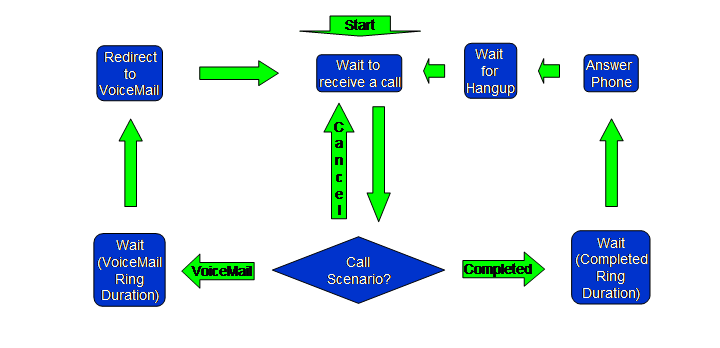
The above Figure shows the user model for the UAS. Note that the UAS
must know which call scenario is being performed, and receives this information
from the UAC via the User-Agent: header. Note that in the
Cancel call scenario, the UAS returns to the "Wait to receive a call" state
and effectively does nothing.
4.4.3
UDE Device Model

The above Figure shows the user model for the UDE.
4.5
Use Case Scenarios
4.5.1
Registration Scenario 1: Successful Registration
This scenario models the process of user registration in a SIP environment.
Registration is common to many SIP applications. Each user has a unique
public SIP identity, and must be registered and authenticated to the
SUT before being able to receive any messages. Through registration,
each user binds its public identity to an actual UA SIP address (i.e.,
IP address and port number). In general, SIP allows multiple addresses
to be registered for each user. In the benchmark, however, for simplicity,
a maximum of one such UA address is allowed to be registered for a single
public identity.
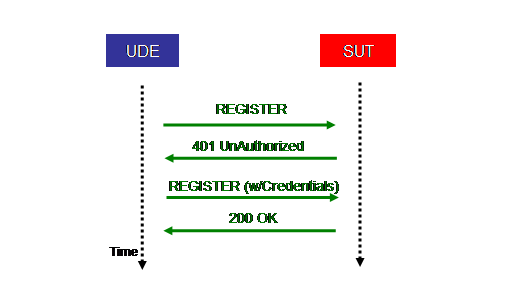
The above Figure shows the call flow for the successful registration
scenario, which proceeds as follows:
- The UDE sends an initial REGISTER request to the SUT with the SIP
To: header set to the user’s public identity (SIP URI).
- The SUT then generates a challenge and sends a 401 (Unauthorized)
response back to the UDE with the challenge.
- After receiving the 401 response, the UDE generates a credential
based on an MD5 hash of the challenge and the user password.
- The UDE then re-transmits the REGISTER request to the SUT with an
Authorization: header that includes the credential.
- The SUT extracts the public identity, and examines the user profile.
- The SUT verifies the credential and sends back a 200 (OK) response.
In general, it is possible in some cases to cache the nonce that is used
in the challenge, so that the Authorization header can be re-used on
later SIP request without necessitating going through the 401 response
above. However, for security reasons, the nonce is valid for only a limited
period of time. SPEC SIP assumes that any nonce would have expired and
thus the authorization exchange above is necessary for each transaction.
4.5.2
Call Scenario 1: Completed Call

The above Figure shows the call flow of the first stage of the INVITE
part of the Completed call scenario. The message flow is as follows:
- The UAC sends an initial INVITE request to the SUT.
- The SUT sends a 100 (Trying) response to the UAC.
- The SUT generates a challenge and sends a 407 (Unauthorized) response
back to the UAC with the challenge.
- The UAC sends an ACK request for the 407, completing the first INVITE
transaction.
- The UAC generates a credential based on an MD5 hash of the challenge
and the user password.
- The UAC then re-transmits the INVITE request to the SUT with an
Authorization: header that includes the credential, creating a new
transaction.
- The SUT extracts the public identity, examines the user profile,
and verifies the credential.
- The SUT sends a 100 (Trying) response to the UAC.
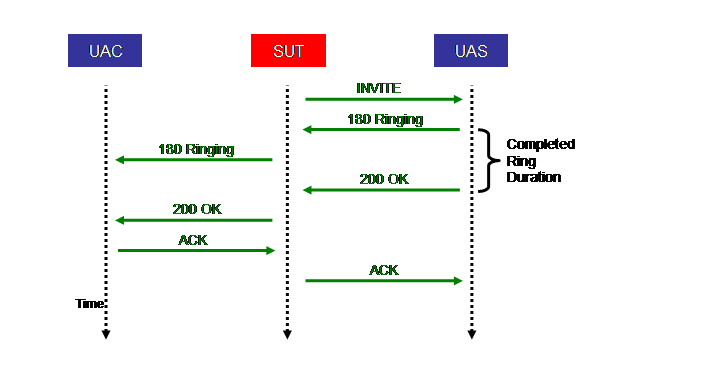
The above Figure shows the call flow of the second stage of the INVITE
part of the Completed call scenario. It proceeds as follows:
- The SUT forwards the authenticated INVITE request to the UAS.
- The UAS sends a 180 (Ringing) response, which the SUT forwards back
to the UAC.
- The UAS sends a 200 (OK) response, which the SUT forwards back to
the UAC.
- The UAC sends an ACK request, which the SUT forwards to the UAS.
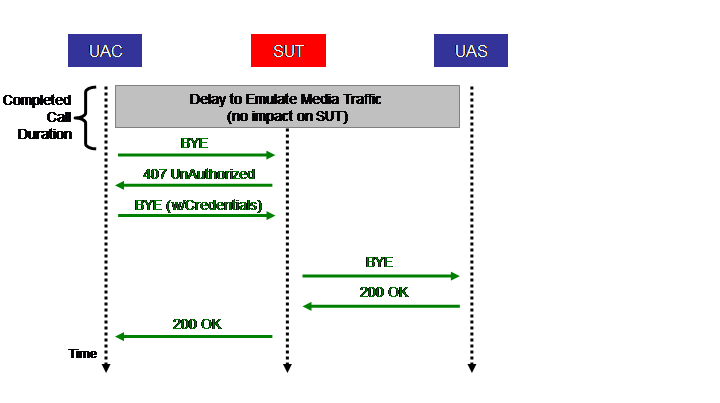
The above Figure shows the call flow of the BYE part of the Completed
call scenario. It proceeds as follows:
- The media portion is emulated by the UAC by waiting for CompletedCallDuration
seconds. No action is taken by the SUT.
- The UAC generates a BYE request, which is challenged by the SUT
with a 407 (Unauthorized) response.
- The BYE is retransmitted with the proper credentials.
- The SUT extracts the public identity, and examines the user profile.
- The SUT verifies the credentials in the retransmitted BYE request,
and then forwards the BYE to the UAS.
- The UAS sends a 200 (OK) response, which the SUT forwards back to
the UAC.
4.5.3
Call Scenario 2: VoiceMail Call

The above Figure shows the call flow of the first stage of the VoiceMail
call scenario. It is identical to the first part of the Completed call
scenario in Section 4.3.2. For that reason we do not repeat the description
of the steps here.
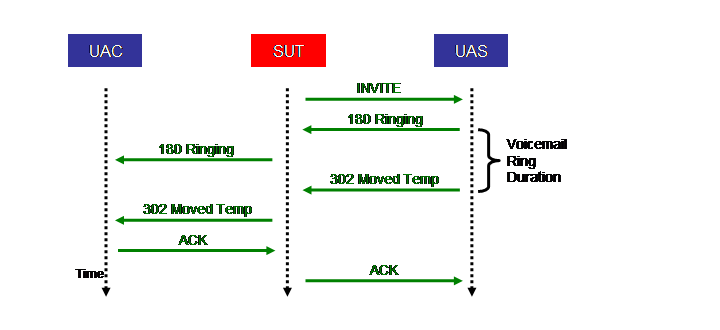
The above Figure shows the second part of the VoiceMail call scenario.
It proceeds as follows:
- The SUT forwards the authenticated INVITE request to the UAS.
- The UAS sends a 180 (Ringing) response, which the SUT forwards back
to the UAC.
- The UAS sends a 302 (Moved Temporarily) response, which the SUT
forwards back to the UAC.
- The UAC sends an ACK request, which the SUT forwards to the UAS.
The remainder of the callflow is a standard SIP session setup and teardown
between the UAC and the voicemail server, which acts as a UAS. Since
the remainder of the callflow does not involve the SUT, it is not shown.
This is similar to Section 6.2 in RFC 4458. The session setup and teardown
between the UAC and the voicemail server does not need to be implemented
by the UAC in practice. The VoiceMailCallDuration, however, must be implemented
by the UAC, since it contributes to the time before the UAC generates
the next call.
4.5.4
Call Scenario 3: Canceled Call

The above Figure shows the call flow of the first stage of the INVITE
part of the Canceled call scenario. It is identical to the first part
of the Completed call scenario in Section 4.3.2. For that reason we do
not repeat the description of the steps here.
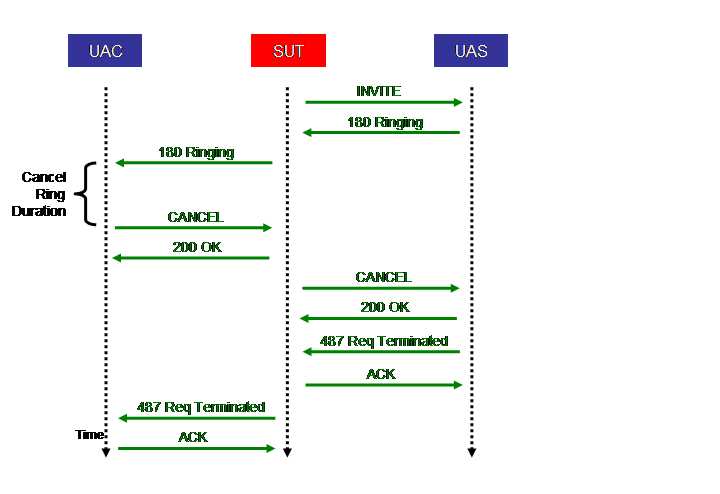
The above Figure shows the call flow for the remainder of the Canceled
call scenario. It proceeds as follows:
- The SUT forwards the authenticated INVITE to the UAS.
- The UAS sends a 180 (Ringing) response, which the SUT forwards back
to the UAC.
- The UAC reacts to the 180 (Ringing) response by generating a CANCEL
request to the SUT.
- The SUT reacts to the CANCEL request by sending a 200 (OK) response
to the UAC.
- The SUT sends a CANCEL request to the UAS.
- The UAS reacts to the CANCEL request by sending a 200 (OK) response
to the SUT.
- The UAS sends a 487 (Request Terminated) response to the SUT.
- The SUT sends an ACK request to the UAS.
- The SUT sends a 487 (Request Terminated) response to the UAC.
- The UAC sends an ACK request to the SUT.
While it is possible for race conditions to occur (e.g., the UAS picks
up before the CANCEL request arrives at the UAS), for simplicity, these
are not modeled by SPEC SIP.
5
Client Workload Generator Details
SIPp is used as a load driver to generate, receive and respond to SIP
messages. SIPp is a de facto standard workload generator for SIP and
is available via Open Source at http://sipp.sourceforge.net/.
SIPp supports a wide array of features including:
- Multiple transports: TCP, UDP, and SSL (TLS)
- Authentication
- UDP retransmissions
- Regular expression matching
- Simple flow control and branching
- RTP replay and echo
SIPp is programmable; its behavior is controlled by an XML scenario file
in which a user or device model is specified as a series of messages
to be sent and expected responses to be received. As an example, three
logical instantiations of SIPp are required for the benchmark, each of
which implements one portion of the user/device model:
- The user agent client (UAC) that initiates new calls.
- The user agent server (UAS) that receives calls.
- The user device emulator (UDE) that registers the IP address of
the user.
Each portion is implemented via a specific SIPp XML file.
SIPp also supports reporting results at predetermined intervals using
a statistics file. The statistics file is like a CSV file, but is delimited
by semicolons rather than commas. The statistics file displays the number
of created calls, successful calls, failed calls, and response time distributions.
6 SUT Details
The SUT providing the VoIP application is responsible for user location
registration, call routing, authentication, and state management. It
is a proxy and registrar application that receives, processes and responds
to SIP messages from the load drivers (UAC, UAS, and UDE). In addition,
it also retrieves and archives the user’s registration information
and accounting information. It must, of course, conform to RFC 3261.
6.1 SUT Accounting
The SUT is required to log all SIP transactions to disk during the run
for accounting and administrative purposes. It also enables billing and
aids in management and capacity planning. This log will be required to
be provided to the SPEC SIP SubCommittee for publishing performance results.
The format of the log is not specified; instead, the following information
is required to be in the log, in any format chosen by the SUT (e.g.,
in compressed format). When results are submitted, a script must be provided
that transforms the log into text that can be analyzed (e.g., a perl
or awk script).
The following information is logged for every SIP transaction:
| Record Name |
Implied Type |
Definition |
| TransactionType |
VARCHAR(16) |
BYE, CANCEL, INVITE, REGISTER |
| FinalResponse |
INTEGER |
Final Response Code (200, 302, 487) |
| FromUser |
VARCHAR(64) |
User Name |
| ToUser |
VARCHAR(64) |
User Name |
| Call-ID |
VARCHAR(256) |
Call ID |
| Time |
TIMESTAMP NOT NULL |
Time Event Occurred |
Implied Type means the type of the record that will be produced by the
script when processed on the transaction log. It does not mean that the
log must specifically use that type. For example, one can imagine using
a single byte to encode a transaction type, rather than a variable-length
string, for efficiency.
Each SIP transaction generates a log entry for that particular transaction:
INVITE, BYE, CANCEL, and REGISTER. ACK requests do not need to be logged,
since they are considered part of the INVITE transaction. Similarly,
authentication challenges do not need to be logged, such as the initial
REGISTER request that is challenged with a 401 (Unauthorized) response.
Only the successful REGISTER transaction that completes with a 200 (OK)
response needs to be logged.
TransactionType is the SIP transaction being logged. In this test, it
will always be INVITE, BYE, CANCEL, or REGISTER.
FinalResponse is the final response code (200 or greater) for the transaction.
In this test, it should always be 200 (OK), 302 (Moved Temporariliy)
or 487 (Request Terminated).
FromUser is the user the request originates from (the caller).
ToUser is the user the request is destined to (the callee).
Call-ID is the Call-ID: used in the transaction which uniquely identifies
the call.
Time is the absolute time when the event occurred in milliseconds.
The idea is that given a stream of events, a provider can produce accounting
information by running a post-processing step on the log and reconciling
items. This is why the Call-ID is included: to match an INVITE transaction
with the matching BYE or CANCEL transaction. Given this information,
for example, call duration can be calculated and the appropriate accounting/billing
performed.
7 Harness Details
The harness is an infrastructure that automates the benchmarking process.
It provides an interface for scheduling and launching benchmark runs.
It also offers extensive functionality for viewing, comparing and charting
results. The harness consists of two types of components: master and
client.
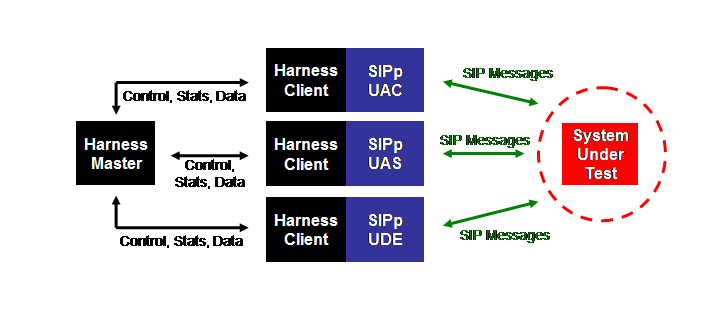
The above Figure shows a more detailed version of the logical architecture
presented in Section 2.1. It shows how the harness master communicating
with the harness clients, which are co-located with and control the SIPp
instances that provide the UAC, UAS, and UDE workload generators.
The harness master is the node that controls the experimental setup. It
contains a Web server, a run queue, a log server and a repository of
benchmark code and results. The master may run on a client machine or
on a separate machine. The Web server facilitates access to the harness
for submitting and managing runs, as well as accessing the results. The
run queue is the main engine for scheduling and controlling benchmark
runs. The log server receives logs from all clients in near real time
and records them.
The harness client invokes and controls each workload generator. It communicates
with the master for commands to deploy the configuration to the workload
generators, and to collect benchmark results, system information and
statistics.
7.1
Benchmark Configuration
To run a benchmark, the user first configures the run through the master.
The configuration includes two components: clients and workload.
7.1.1
Client Configuration
Certain client information will be specified by SPEC SIP and is not modifiable
by the user:
- The location of the workload generator executable: the directory
storing the workload generator executable (i.e. SIPp executable)
- Scenario XML file: the location of the scenario XML file for the
workload generator (i.e. SIPp). The scenario could be for UAC, UAS
or UDE.
- Workload statistics collection frequency: the interval (in seconds)
for statistics of transactions collected by each SIPp instance.
Other information is specific to an environment and must be specified
by the user:
- Host names or ip addresses for the SUT, UAC(s), UAS(s), and UDE(s).
- System information and performance data collection tools: Commands
to run tools during benchmarking period for collecting system information,
such as CPU usage, networking statistics, IO statistics etc.
7.1.2
Workload Configuration
Again, certain components are specified by the benchmark and are not
modifiable by the user:
- Traffic Profile: The scenario files (for SIPp) and the mix of scenarios
(in terms of the percentages of various scenarios)
- Traffic Parameters: The constant or the mean of the distribution
listed in Section 4.3.
- Ramp Up Period: Time (in seconds) for the workload to ramp up and
get the SUT into a steady state, outside the measurement interval.
- Steady State Period: Time (in seconds) for the benchmark to run
in the steady state and be measured.
- Ramp Down Period: Time (in seconds) for workload to ramp down, outside
the measurement interval.
Others are specified by the user:
- Workload Scale: The number of users (Q: Should we include increment
of users for benchmarking with multiple phases)
7.2
Run Management and Validation
Once the benchmark configuration is complete, the user can submit the
run request to the master and the request will be put into a queue. If
there are no existing requests, the benchmark run will start immediately,
otherwise it must wait until all previous requests are completed or canceled.
The user can kill the current run or cancel any run in the queue via
the Web interface.
Once the benchmark starts, the master first disseminates configuration
information to to all systems, starts all performance data collection
tools on all client systems, initiates and commands all clients to start
at once.
The harness records each step of the run in a log.
Once a run is complete, the master collects logs and statistics from
all clients, and processes and compiles them into reports. The logs from
load generators will be analyzed and checked against the run rules to
determine whether a run is valid as specified in Section 3, and matches
the traffic profile as specified in Section 4. The harness will then
store a summary, a detailed report, the run configuration and the logs
in its repository.
8
Summary and Conclusion
This is the first version of SPEC SIP benchmark. As such, we have attempted
to keep the design simple, representative, and consistent with the SIP
specification. We expect to release improved versions of the benchmark
in the future, reflecting better understanding of real-world workloads
and experience in running the benchmark itself. We encourage constructive
feedback for improving the SPEC SIP benchmark.
This document is Copyright SPEC 2007. This document shall not be construed
as a commitment to develop a benchmark.
|















